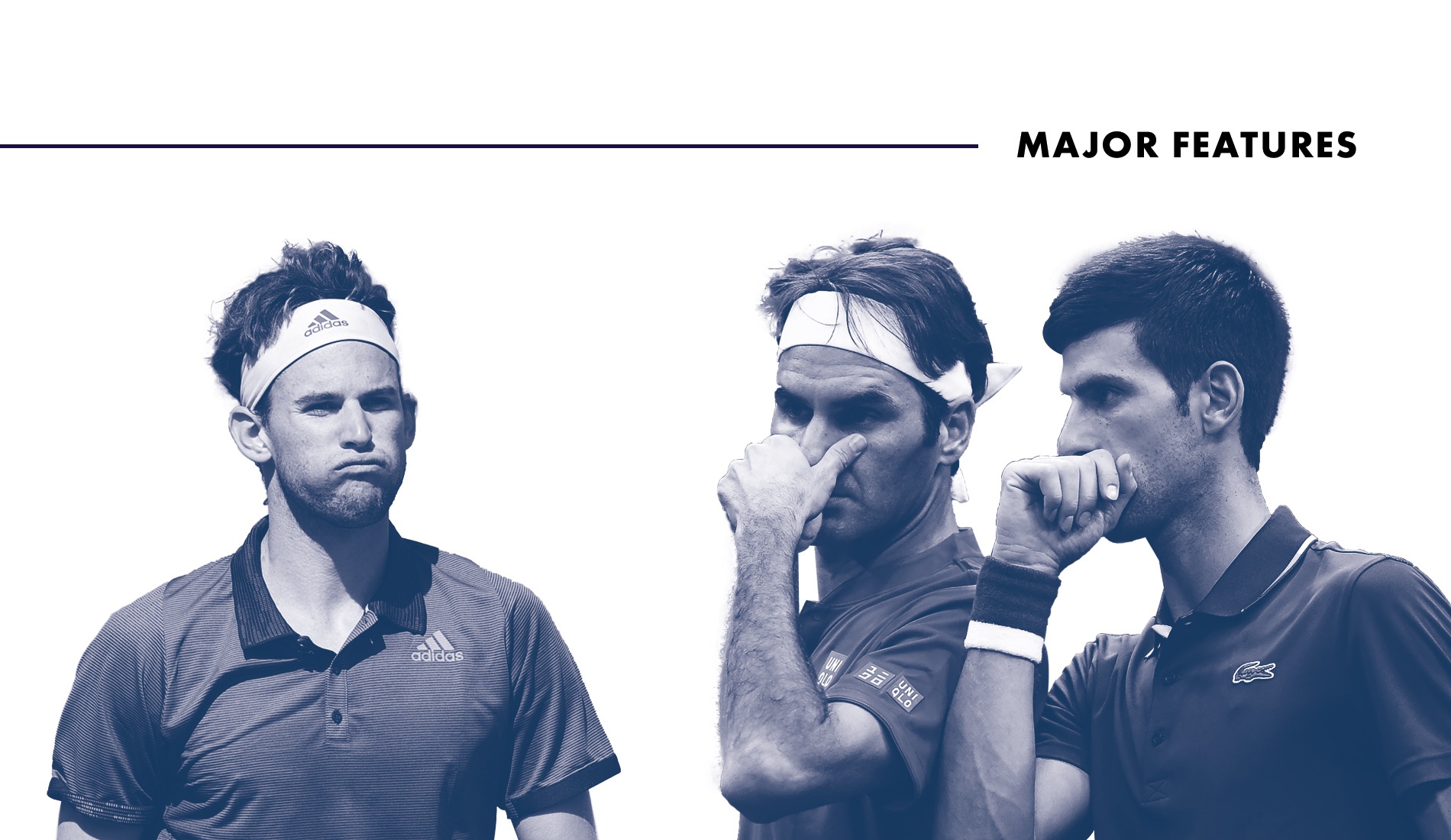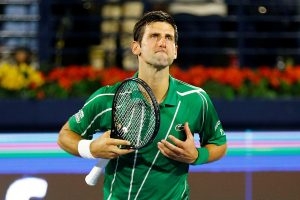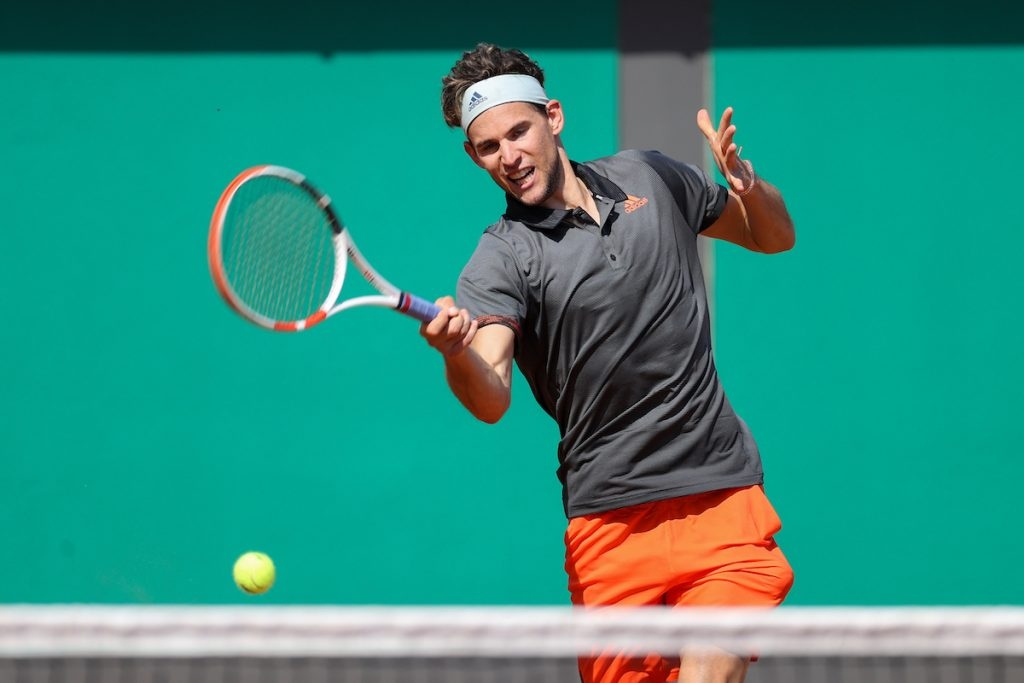Row over player relief funds exposes a divided Tour
Not even the Big 3 has, for now, succeeded in convincing ATP players to give money to their lower-ranked colleagues who are struggling through the Covid-19 outbreak.
 Dominic Thiem, Roger Federer, Novak Djokovic, for the Tennis Majors feature about player relief funds.
Dominic Thiem, Roger Federer, Novak Djokovic, for the Tennis Majors feature about player relief funds.
The governing bodies took their time but ended by announcing funding for those who are finding life difficult with no tennis. But the players themselves, asked by an initiative led by Novak Djokovic to contribute to a relief fund for the lower-ranked players, are still fighting over the principle. Showing an astounding lack of unity and solidarity.
Unity seems a constant struggle
For those still wondering why the idea of a players’ union remains just an idea, or why it can take ages to change anything in tennis, the current situation of the players’ relief funds is another example why. Simply because uniting all the players or even most of the players for a common goal and course of action is a mission that only Ethan Hunt might qualify to take.
Players have not had the chance to earn any prize money since the Tour was suspended in March. A nuisance for all involved, of course, but for the players outside the top 100, it’s reaching dramatic proportions. The gap between the stars of the game and the rest is widening, as wide as the difference in the paychecks from the sponsors, for those who have any.
That’s why Djokovic, the president of the ATP Players’ Council, addressed his colleagues mid-April to offer a solution. A solution discussed with Rafael Nadal and Roger Federer. Usually, when the Big 3 wants something to happen, it happens. And so the issue of players wondering how to pay the rent or the food, close to jumping from the professional train, was supposed to be solved. The plan was quite clear and would generate $4 million for the players ranked from No 250 to No 700, on top of the $1 million dollars already promised by the ATP for those ranked between No 150 and No 400.
The plan was for each of the top 100 in singles and top 20 in doubles to give a certain amount of money, decided by their respective rankings; the top five would give $30,000 each; then $20,000 from No 6 to No 10; $15,000 from No 16 to No 20; $10,000 from No 21 to No 50 and then $5000 each from No 51 to No 100. Doubles players in the Top 20 were asked to give $5000 each. The overall goal was to give $10,000 to each player ranked from No 250 to No 700. The Big 3 had talked, case closed, now off to open your wallets, people.
Governing bodies for the rescue
Except that three weeks later, nothing has been done. Not a dollar has been given. This players’ relief fund remains in limbo. Why? Well, obviously because players don’t want to pay. Reviewing the whole prize money distribution scheme is a thing they all agree with, but sharing their own pie even in a pandemic: no, it’s not coming off as easy as one might have thought.
Also, while they were stuck in those talks, the tennis bodies announced on April 21st that they would join forces and put more than 6 million dollars in a relief fund for players ranked outside the top 250; $1 million per grand slam event, $1 million each from the ATP and WTA and an undisclosed amount, as yet, from the ITF. It was confirmed and announced on May 5th that the fund was ready to go and would concern around 800 players. “Eligibility for the Player Relief Programme will take into account a player’s ranking as well as previous prize money earnings according to criteria agreed by all stakeholders”, it added.
The governing bodies of world tennis are pleased to announce the details of the Player Relief Programme, with over US $6 million raised to support players who are particularly affected by the ongoing impact of COVID-19 ⬇️#Wimbledonhttps://t.co/Hhvg1YczNd
— Wimbledon (@Wimbledon) May 5, 2020
In France, the FFT announced it would give 35 million euros to grassroots tennis, clubs, and players, while the British LTA, announced a £20 million plan. Coincidence or not, the players’ fund, led by players, seemed to fall in a hole somewhere behind the scenes around the time of those announcements. But it is also not simple. Many players are from federations who can’t provide any help, and many don’t have sponsors to fill the void.
A responsability to the game
Of course, it was also up to the institutions to put hands in pockets to help their players. But we’ve been told this so many times over the years that it seems a bit odd to now forget that players are contractors of their Tour. Independent ones, yes, but still contractors. It’s then still possible to think that in times of need, they could participate financially to the rescue.
That was obviously the train of thought of the Big 3 and those who were supporting their idea. Everyone is struggling, but for those who struggle less, let’s help those whose situations are dire. The responsibility to the game might here be extended to its players in a solidarity gesture.
But no, in such a competitive and individualist sport, it has so far proved impossible to convince even some of the wealthiest players to give to those who right now have nothing. Thus, someone like Dominic Thiem, currently world No 3 and with nearly $24 million dollars in career prize money, openly rejected the idea.
Why? Because he thinks some of those players aren’t worthy enough for him to contribute $30,000 dollars to a fund. When some are now saying top players should have been told to give a lot more than $30,000 for that fund to be accepted by the majority, it seems already way too much for someone like the Austrian, so imagine if he had been asked double.
At least Thiem went public with his thoughts when he talked to Krone Sport: “None of the lower-ranked players have to fight for their lives”, he said.
“I’ve seen players on the ITF Tour who don’t commit to the sport 100 percent. Many of them are quite unprofessional. I don’t see why I should give them money. I’d rather donate to people and institutions who really need it. There is no profession in the world where you are guaranteed success and high income at the start of your career. None of the top players took anything for granted. We all had to fight our way up the rankings.”
“Many of them are quite unprofessional. I don’t see why I should give them money” – Thiem
Asked by Sky Austria to follow up on this, Thiem said that his words might have come through too harsh but didn’t back down from his main opinion:
“What I said came across as a bit strong. I didn’t say it so strongly. I’d much prefer it to be chosen by the players themselves because then those players who really need it and who really deserve it will benefit.”
Maybe a way out of this would be for him to give a list of players he refuses to give money to and then ask the other members of the top five to compensate.
Former world No 1 Lleyton Hewitt also opposes the principle of the relief fund, stating that he feels it is unfair for the player ranked 100 to have to give to the one ranked 101 despite the fact that he himself may also be struggling. Well, you have to make a cut somewhere, no? And the top 100 are the ones getting into the main draw of the biggest tournaments, assuring them of minimum prize money.
But Hewitt argued that someone like James Duckworth, ranked No 83, shouldn’t have to be requested to share the burden.
“In the last few years, he’s done everything right to give himself the best opportunity to get himself back in the top 100,” the Australia Davis Cup captain told Channel Nine’s Wide World of Sports. “He’s making no money right now. He’s running at a loss, yet the ATP wants him to potentially donate five or ten thousand dollars to players ranked just outside 100. I don’t think that sits well. I don’t think it’s going to get over the line with a lot of those lesser players.”
Since the start of the year, Duckworth has won $121,317.
Dustin Brown, now ranked No 239, took to Twitter to tell Thiem what he thought of his comments:
Startin In 2004 I Lived In A Camper, Surviving From Week To Week With The Money I Made… Losing First Round In A 10k Was 117,50$ – Tax… Because Of This I Was Also Stringing Rackets For Other Players For 5€ A Pop… If This Would Happend Then, It Would Have Cost Me My Career!! https://t.co/xVPzXTSqIw
— D. Brown (@DreddyTennis) April 26, 2020
Jan-Lennard Struff, ranked No 34, didn’t blink an eye when asked if he’d support that fund.
“You have to look at it from two sides. Of course, I have no income, but I have managed to play well in the last few years and have been able to put some money aside. I think it’s a good idea. I would like to support this, of course”, the German told Stats Perform.
Stefanos Tsitsipas doesn’t seem to be on Thiem’s side either as he has now also launched, with Patrick Mouratoglou, his own players’ relief system, called Beyond 100 , via auctions, for those ranked outside of the top 100. There have been other initiatives, too, like The Mutua Madrid Open of Madrid, which went virtual in April and gave 150.000 euros to each winner of the men and women draw, a portion of which they gave away to charities and relief funds.
Darren Cahill praises the players’ initiative of the relief fund, but points to the bigger picture. The Australian, the coach of Simona Halep, feels some players are paying for what he believes are the Tour’s mistakes.
“The players are doing a wonderful thing by studying the discussions to start this relief fund. It’s important because I feel like the ATP and the WTA have failed tennis in the last 10, 20 years, and not enough players have been able to make a living out of the game. When I played, 30 years ago, about 150 players were making a living and staying afloat playing the game. And it’s still the same now, whereas the money is much, much greater. That responsibility lies on the ATP and the WTA, and they haven’t lived up to it. The Grand Slams have made big steps in the last ten years to put a lot more money into the first, second, and third rounds and also into qualifying. They’ve made big steps forward to help as many players as they can. So I think this responsibility really lies with the ATP and the WTA. And hopefully, this is a big wake up call for those two associations to make sure that we start to get more prize money into the lower tier events.”
Nothing reassuring about the state of the Top 100
In an individual sport, you’re always going to have issues with any joint action, especially ones requiring the professional athletes to give a share of their hard-fought-for money. Even with those who have enough money to last a few generations. And even when there’s an emergency.
Tennis is no exception, and this crisis also landed at a time when the players have been annoyed and frustrated for years now by the way the prize money is distributed. Had the system been fixed a long time ago, those players ranked around 250 wouldn’t be in the state they’re in now, and no one would have to count on the generosity of the millionaires in the sport.
Still, it would have been reassuring to see all the Top 100 players leading by example by contributing without drama to that players’ relief fund. Seeing them unable to get together to help their own colleagues in a once-in-a-century crisis doesn’t exactly lead to optimism, that they could come together for almost anything that matters, be it a union, the prize money distribution, the sport’s rules or the format.
Word is that the WTA also asked its players to contribute to a funding effort for the lower-ranked players. Simona Halep already saying she would contribute. It’s left to see if the women will have more success efficiently rallying the troops than the men have had.
Avoiding another layer of disaster
It’s in the interest of the whole sport to avoid having a bunch of players go bankrupt, as we also know that the lowest-ranked players are the ones most susceptible to fall into betting pitfalls. Ensuring that as many professional tennis players as possible can make a decent living is like ensuring that in the case of a pandemic they won’t be out of a job and of their houses after a couple of months. It’s the decent thing to do and it’s also the best way to prevent them from turning to the dark side.
Revamping the Challenger level and starting to think about reforming prize money distribution was seen by the Tour as a tool against betting offences. It’d be an even bigger disaster if Covid-19 also opened a door for corruption.
In the end, people outside of the game and inside it, like those lower-ranked players, will remember who led the way toward solidarity, and who opted out. In tennis politics, that’s the kind of thing that could have consequences. Especially as voices are rising for a change of the tennis structure (commissioner, merger).
The players’ relief fund debate is making it clear who tried to right the ship and who waited to see if it was really going to sink and if someone was going to come and help before they had to join the rescue team. The issue for tennis right now is that this crisis keeps showing how divided it is.
• Another Majore Feature : How fit, or not, will be the players at the end of confinement ?
• Another Major Feature : The good old commissionner idea is back (and this time, there’s a chance)
• Another Major Feature : 99% of the coaches are not paid, and they won’t stand waiting for a change






